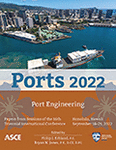Sheet Pile Wall Failure Case Studies: Causes and Lessons Learned
Publication: Ports 2022
ABSTRACT
Cantilever and anchored sheet pile bulkheads are routinely used for retaining the backfills and excavations in marine engineering. Furthermore, as the global economy becomes increasingly integrated, the necessity for larger container vessels and port capacity rises. The sheet pile walls are critical to enabling the construction of modern facilities necessary to attract these ships that are vital to the economic health of the ports to allow the harbor bed to be dredged to depths required by modern vessels or support the upland. However, many sheet piles fail due to high stress and/or loss of long-term serviceability. An appropriate analysis and design method and proper understanding of sheet pile walls’ behavior can prevent the occurrence of such failures significantly. In this paper, first, several case studies of sheet pile wall failures collected from the inspections at the ports and other marine structures are presented, and probable causes are discussed and evaluated using lateral load analysis. Next, both embedment depth to ensure the stability and maximum bending moments are predicted based on three different methods: finite element, P-Y model, and limit equilibrium method (LEM). These three methods are widely used in the marine industry for analyzing sheet piles, and several software has been developed in the past based on the aforementioned methodologies. Results suggest that identifying the possible failure of the sheet pile walls is critical in the design. Also, results indicate that sheet pile response predictions based on the P-Y model and finite element methods are greater than the corresponding values from the LEM, depending on the soil parameters, sheet pile stiffness, and anchorage condition. The location of the fixity obtained from both finite element and the P-Y methods was found to be consistent. Some increase in bending moments and embedment obtained by the LEM may therefore be warranted depending on the wall boundary conditions and soil parameters. Furthermore, it was found that many sheet pile wall failures can be attributed to improper analysis methodology and/or overlooked design details and the site condition.
Get full access to this article
View all available purchase options and get full access to this chapter.
REFERENCES
USACE. (1996). “Design of sheet pile walls”,.
Paikowsky, S. G., and Tan, Y. (2005). Sheet pile wall design and performance in peat Geotechnical Engineering Research Laboratory.
Evans, R. R. (2010). Modified sheet pile abutments for low volume road bridges. Digital Repository @ Iowa State University.
Greimann, L. F. (1987). Pile design and test for integral abutment bridges, Engineering Research Institute.
Wall, H., and Wadsö, L. (2013). Corrosion rate measurements in steel sheet pile walls in a marine environment. Marine Structures, 33, 21–32.
Clough, G. W., and O’Rourke, T. D. (1990). “Construction-induced movements of in situ walls. In: Design and performance of earth retaining structures. Geotech spec pub 25. ASCE; p. 439–70.
Ou, C. Y., Chiou, D. C., and Wu, T. S. (1996). Three-dimensional finite element analysis of deep excavations. Journal of Geotechnical Engineering, 122(5), 337–345.
Sugano, T., Nozu, A., Kohama, E., Shimosako, K. I., and Kikuchi, Y. (2014). Damage to coastal structures. Soils and Foundations, 54(4), 883–901.
DiBiagio, E. (1977). “Filed instrumentation, a geotechnical tool.”, Norwegian Geotechnical Institute, Oslo, Norway, 29–40.
Bentler, J. G., and Labuz, J. F. (2006). “Performance of a cantilever retaining wall.” J. Geotech. Geoenviron. Eng., 132 (8), 1062–1070.
Terzaghi, K. (1934). “Large retaining wall tests-I.” Eng. News-Rec., (85 ) (February 1–April 19), 136–140.
Coyle, H. M., and Bartoskewitz, R. E. (1976). “Earth pressure on precast panel retaining wall.” J. Geotech. Eng. Div., 102(GT5), 441–456.
Bentler, J. G., and Labuz, J. F. (2006). “Performance of a cantilever retaining wall.” J. Geotech. Geoenviron. Eng., 132(8), 1062–1070.
Peck, R. B. (1943). “Earth pressure measurements in open cuts, Chicago (ILL). subway.” Trans. Am. Soc. Civ. Eng., 1943 (108), 1008–1036.
Finno, R. J. (1989). “Subsurface conditions and pile installation data.” Proc., Symp. on Predicted and Observed Behavior of Piles, Evanston, Geotechnical Special Publication No. GSP 23, ASCE, Reston, Va., 1–74.
Bjerrum, L., Frimann, L. J., Has, M., and Duncan, J. M. (1972). “Earth pressures on flexible structures-a state-of-the-art report”. In: 5th European conference on soil mechanics and foundation engineering, vol. 2, Madrid; p. 169–96.
Potts, D. M., and Fourie, A. B. (1984). The behaviour of a propped retaining wall: results of numerical experiment. Geotechnique, 34(3), 383–404.
Rieke, R. D., Crowser, J. C., and Schroeder, W. L. (1988). Bulkhead failure investigation and redesign. Journal of geotechnical engineering, 114(10), 1110–1125.
Sowers, G. B., and Sowers, G. F. (1967). Failures of bulkhead and excavation bracing. Civil Engineering.
Endley, S. N., Dunlap, W. A., Knuckey, D. M., and Sreerama, K. (2000). Performance of an anchored sheet-pile wall. In Geotechnical Measurements: Lab and Field (pp. 179–197).
Terzaghi, K. (1953). “Anchored bulkheads”, Proc. ASCE, 79.
Terzaghi, K. (1954). “Anchored bulkheads”, (with discussion), Trans. ASCE, 119, 1243–1324.
Rowe, P. W. (1955). “A theoretical and experimental analysis of sheet pile walls”, Proc. ICE, Part 1, 4, 32–69.
Richart, F. E. (1957). “Analysis for sheet pile walls”, Trans. ASCE, 122, 1113–1132.
Hansen, J. B. (1953). Earth pressure calculations, Institute of Danish Civil Engineers, Copenhagen.
Matlock, H., and Reese, L. C. (1960). Generalized solutions for laterally loaded piles. Journal of the Soil Mechanics and foundations Division, 86(5), 63–94.
Reese, L. C., Cox, W. R., and Koop, F. D. (1974). Analysis of laterally loaded piles in sand. Offshore Technology in Civil Engineering Hall of Fame Papers from the Early Years, 95–105.
Reese, L. C., and Welch, R. C. (1975). Lateral loading of deep foundations in stiff clay. Journal of Geotechnical and Geoenvironmental Engineering, 101 (ASCE# 11456 Proceeding).
Information & Authors
Information
Published In
History
Published online: Sep 15, 2022
Authors
Metrics & Citations
Metrics
Citations
Download citation
If you have the appropriate software installed, you can download article citation data to the citation manager of your choice. Simply select your manager software from the list below and click Download.
